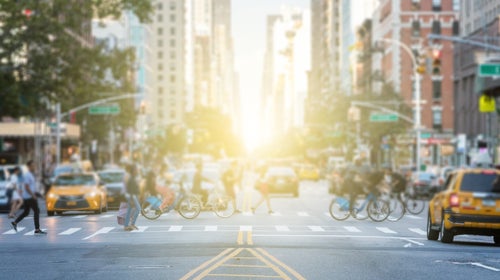Over the past 20 years electric vehicle technology ,��commercially available, and extremely viable��tool��for reducing emissions and blunting the effects of climate change.��There are even economic incentives for purchasing electric cars.��Since��2005, the federal government has offered��buyer tax credits of up to $7,500��for hybrids and plug-in electric vehicles. That makes sense: if you want to use economic nudges to address climate change, you should focus first on the most popular behaviors, like driving. It’s been an impressive success. Just 17,763��plug-in EVs were sold in 2011 nationwide.��In 2018, as further��federal incentives for both buyers and carmakers drew more manufacturers into the market, EV��sales to over 360,000.
But up to now, we’ve largely ignored one of the most powerful tools for shifting away from internal combustion engines: the e-bike. After all, the best way to lower emissions from personal travel is to get people out of cars altogether. And bikes are arguably the most energy-efficient form of transportation we’ve ever devised: .
Modern e-bikes have as the hybrid car, which first came out 23 years ago. But so far, financial incentives for e-bikes have only existed at the local and,��,��state levels. They’re modest in size, limited in scope, more difficult to claim than EV incentives, and most people have no idea they even exist. As federal electric car tax credits from the 2009 American Recovery Act ,��and the pandemic bike boom��continues to bring more cyclists onto city streets,��maybe it’s time—long past due—for a federal incentive program for e-bikes.
Thankfully, California’s Jimmy Panetta and Oregon’s Earl Blumenauer agree. In February, the two Democratic representatives introduced HR 1019, the E-BIKE Act. The bill is short��and simple: it would provide a federal tax credit of 30 percent of the purchase value of an e-bike, available to an individual��once every three years, capped at $1,500 and applicable to e-bikes costing less than $8,000. That’s far more generous than the thin patchwork of state and local incentives that currently exist, ranging from $200 rebates from utilities like Vermont’s Green Mountain Power to as much as $700 for California’s Clean Cars For All program.
Blumenauer said the idea behind his and Panetta’s new bill is to incentivize exactly the kind of e-bikes that are becoming popular: utility models between $1,000 and $7,000 that are perfect for replacing car trips in metro areas. “We’ve seen an explosion of interest in e-bikes,” Blumenauer told �����ԹϺ���. “And this comes at a time where there’s not just renewed interest in cycling, but a realization that we’re in a [climate]��struggle. The future of the planet needs to be a low-carbon future, and e-bikes can significantly accelerate that transition.”
To be sure, this is . And no one knows better than Blumenauer that the path for a bike bill to become law is long and difficult. Blumenauer has represented Oregon’s 3rd Congressional District, which includes much of Portland, since 1996, and is known for his extensive bowtie collection and his love of bikes. In D.C. he commutes regularly on a Trek Portland. He’s sponsored 38 bike-related bills in his time on Capitol Hill, and gotten several key wins, including a bike-commuter tax benefit. (It was later eliminated in the 2017 tax-cut bill passed by Republicans, but Blumenauer is trying to revive it this legislative session with another bill.)
“It’s hard these days to have standalone legislation,” Blumenauer concedes. The best path is likely to get folded into a larger package. He points to the ��unveiled in late March by the Biden administration as a likely candidate.
Getting the bill passed��won’t be easy. With an $8,000 purchase-price ceiling,��opponents will level the at��this bill that they��used against electric car incentives: that the tax credit means no one wants an e-bike, or that owning one is just virtue-signaling for rich liberals. “The e-bike isn’t a Tesla, for heaven’s sake,” says Blumenauer when asked about it. A modest tax credit on e-bikes is “the most cost-effective way to decrease carbon emissions. And that affects everybody.”
Noa Banayan, federal affairs manager��at advocacy group , points out that the purchase price cap hits a sweet spot. It includes almost every utility e-bike sold, even big frontloaders like , but is below the price of some (if not all) high-end enthusiast road and mountain models.
Right now, the act has 10 co-sponsors, all Democrats. But Blumenauer is big on what he calls “bike-partisanship.” He points out that the Congressional Bike Caucus, which he founded his first year in Congress, now has over 100 members. “Two-thirds of the states are represented,” he says. And he hopes he can count on��Bike Caucus co-chair Vern Buchanan (R-FL)—who also sits on the Ways and Means Committee, where the bill is directed—to help reach across the aisle to build support.
Assuming Panetta and Blumenauer can shepherd the bill to success, there’s a bigger question: will it lead more people to buy e-bikes and use them instead of driving?
We don’t know for sure, but indications are encouraging. Because incentive programs aren’t widespread in the US, there isn’t good data on behavioral change here. So, People For Bikes looked internationally. One primary resource is��a from , the co-director of Universtiy of California-Davis’s BicyclingPlus Research Collaborative. Fitch analyzed a set of European studies on��e-bike purchase-incentive programs. “Incentives between 20 and 33 percent of the cost were most popular,” Banayan told �����ԹϺ���, “and also showed the best factor of increasing adoption and ridership.”��As for switching car trips to bikes, Fitch found that between 35 and 50 percent of reported e-bike trips in the study set would have otherwise been done by car.
According to Banayan, People for Bikes feels the U.S. is ready for large-scale adoption of e-bikes. “We’re seeing anecdotally and through research just how much people are realizing they can do with electric bicycles instead of taking their car,” she said. The range of potential adopters is large. There’s the longtime bike commuter for whom an e-bike upgrade means a less-sweaty ride to work. There’s the parent who is tired of being stuck, sedentary, in car traffic while shuttling children to school and sports practices that are in easy riding distance—if only there was a way to carry both kids and their stuff. And then there are the people who would be interested, if only they knew it was even an option.
That’s the key: for adoption to happen at real scale, people have to witness that potential and maybe even experience it. , from Portland State’s Transportation Research and Education Center, looked at what makes an incentive program successful in actually changing behavior. Long-term, personal experience seems to be crucial. A six-week e-bike loaner program at Kaiser Permanente offices in Portland in 2017 led to a doubling in the rate of bike commuting, even after the program ended. And an e-bike “lending library” program in Vermont offered week-long trials that resulted in a 17 percent��purchase rate among participants—even six months to a year later. The takeaway is that generous federal tax credits may work best if paired with local demo programs, which could increasingly��include��electric bikeshare fleets.
Ultimately, Blumenaer emphasizes that speeding up the adoption of e-bikes has little to do with “people in Lycra riding fast.” He defines the E-BIKE Act as a climate change bill first and foremost. But, he quickly adds, “having electric bikes woven into the [urban]��landscape isn’t just about the potential of significantly reducing carbon emissions.”��E-bikes, which are widespread, and increasingly affordable and reliable, are a post-pandemic powerhouse for addressing health problems and livable city issues like pollution, traffic congestion, and transportation equity. And there’s no time like now to get started.


